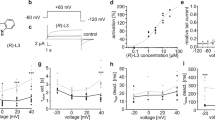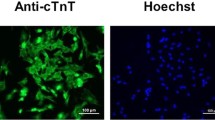Abstract
Trifluoperazine (TFP), a phenothiazine, is a commonly used antipsychotic drug whose therapeutic effects are attributed to its central anti-adrenergic and anti-dopaminergic actions. However, TFP is also a calmodulin (CaM) antagonist and alters the Ca2+ binding properties of calsequestrin (CSQ). The CaM and CSQ proteins are known modulators of sarcoplasmic reticulum (SR) Ca2+ release in ventricular myocytes. We explored TFP actions on cardiac SR Ca2+ release in cells and single type-2 ryanodine receptor (RyR2) channel activity in bilayers. In intact and permeabilized ventricular myocytes, TFP produced an initial activation of RyR2-mediated SR Ca2+ release and over time depleted SR Ca2+ content. At the single channel level, TFP or nortryptiline (NRT; a tricyclic antidepressant also known to modify CSQ Ca2+ binding) increased the open probability (Po) of CSQ-free channels with an EC50 of 5.2 µM or 8.9 µM (respectively). This Po increase was due to elevated open event frequency at low drug concentrations while longer mean open events sustained Po at higher drug concentrations. Activation of RyR2 by TFP occurred in the presence or absence of CaM. TFP may also inhibit SR Ca uptake as well as increase RyR2 opening. Our results suggest TFP and NRT can alter RyR2 function by interacting with the channel protein directly, independent of its actions on CSQ or CaM. This direct action may contribute to the clinical adverse cardiac side effects associated with these drugs.





Similar content being viewed by others
References
Arai M, Otsu K, MacLennan DH, Alpert NR, Periasamy M (1991) Effect of thyroid hormone on the expression of mRNA encoding sarcoplasmic reticulum proteins. Circ Res 69(2):266–276
Beard NA, Casarotto MG, Wei L, Varsanyi M, Laver DR, Dulhunty AF (2005) Regulation of ryanodine receptors by calsequestrin: effect of high luminal Ca2+ and phosphorylation. Biophys J 88(5):3444–3454
Bers DM (2001) Excitation–contraction coupling and cardiac contractile force. Kluwer, Norwell, MA USA
Buckley NA, Sanders P (2000) Cardiovascular adverse effects of antipsychotic drugs. Drug Saf 23(3):215–228
Cachia PJ, Van Eyk J, Ingraham RH, McCubbin WD, Kay CM, Hodges RS (1986) Calmodulin and troponin C: a comparative study of the interaction of mastoparan and troponin I inhibitory peptide [104–115]. Biochemistry 25(12):3553–3562
Chamberlain BK, Volpe P, Fleischer S (1984) Calcium-induced calcium release from purified cardiac sarcoplasmic reticulum vesicles. General characteristics. J Biol Chem 259(12):7540–7546
Choi SY, Koh YS, Jo SH (2005) Inhibition of human ether-a-go-go-related gene K+ channel and IKr of guinea pig cardiomyocytes by antipsychotic drug trifluoperazine. J Pharmacol Exp Ther 313(2):888–895
di Barletta MR, Viatchenko-Karpinski S, Nori A, Memmi M, Terentyev D, Turcato F, Valle G, Rizzi N, Napolitano C, Gyorke S, Volpe P, Priori SG (2006) Clinical phenotype and functional characterization of CASQ2 mutations associated with catecholaminergic polymorphic ventricular tachycardia. Circulation 114(10):1012–1019
Eisner DA, Trafford AW, Diaz ME, Overend CL, O'Neill SC (1998) The control of Ca release from the cardiac sarcoplasmic reticulum: regulation versus autoregulation. Cardiovasc Res 38(3):589–604
Fill M, Copello JA (2002) Ryanodine receptor calcium release channels. Physiol Rev 82(4):893–922
Fliegel L, Ohnishi M, Carpenter MR, Khanna VK, Reithmeier RA, MacLennan DH (1987) Amino acid sequence of rabbit fast-twitch skeletal muscle calsequestrin deduced from cDNA and peptide sequencing. Proc Natl Acad Sci U S A 84(5):1167–1171
Fruen BR, Bardy JM, Byrem TM, Strasburg GM, Louis CF (2000) Differential Ca(2+) sensitivity of skeletal and cardiac muscle ryanodine receptors in the presence of calmodulin. Am J Physiol Cell Physiol 279(3):C724–C733
Fujii J, Willard HF, MacLennan DH (1990) Characterization and localization to human chromosome 1 of human fast-twitch skeletal muscle calsequestrin gene. Somat Cell Mol Genet 16(2):185–189
Gyorke I, Hester N, Jones LR, Gyorke S (2004) The role of calsequestrin, triadin, and junctin in conferring cardiac ryanodine receptor responsiveness to luminal calcium. Biophys J 86(4):2121–2128
Gyorke S, Terentyev D (2008) Modulation of ryanodine receptor by luminal calcium and accessory proteins in health and cardiac disease. Cardiovasc Res 77(2):245–255
Ho MM, Scales DJ, Inesi G (1983) The effect of trifluoroperazine on the sarcoplasmic reticulum membrane. Biochim Biophys Acta 730(1):64–70
Hull BE, Lockwood TD (1986) Toxic cardiomyopathy: the effect of antipsychotic–antidepressant drugs and calcium on myocardial protein degradation and structural integrity. Toxicol Appl Pharmacol 86(2):308–324
Jusic N, Lader M (1994) Post-mortem antipsychotic drug concentrations and unexplained deaths. Br J Psychiatry 165(6):787–791
Kelly HG, Fay JE, Laverty SG (1963) Thioridazine hydrochloride (Mellaril): its effect on the electrocardiogram and a report of two fatalities with electrocardiographic abnormalities. Can Med Assoc J 89:546–554
Knollmann BC, Chopra N, Hlaing T, Akin B, Yang T, Ettensohn K, Knollmann BE, Horton KD, Weissman NJ, Holinstat I, Zhang W, Roden DM, Jones LR, Franzini-Armstrong C, Pfeifer K (2006) Casq2 deletion causes sarcoplasmic reticulum volume increase, premature Ca2+ release, and catecholaminergic polymorphic ventricular tachycardia. J Clin Invest 116(9):2510–2520
Meissner G, Henderson JS (1987) Rapid calcium release from cardiac sarcoplasmic reticulum vesicles is dependent on Ca2+ and is modulated by Mg2+, adenine nucleotide, and calmodulin. J Biol Chem 262(7):3065–3073
Nau C, Seaver M, Wang SY, Wang GK (2000) Block of human heart hH1 sodium channels by amitriptyline. J Pharmacol Exp Ther 292(3):1015–1023
Pancrazio JJ, Kamatchi GL, Roscoe AK, Lynch C 3rd (1998) Inhibition of neuronal Na+ channels by antidepressant drugs. J Pharmacol Exp Ther 284(1):208–214
Park IY, Kim EJ, Park H, Fields K, Dunker AK, Kang C (2005) Interaction between cardiac calsequestrin and drugs with known cardiotoxicity. Mol Pharmacol 67(1):97–104
Picht E, Zima AV, Blatter LA, Bers DM (2007) SparkMaster: automated calcium spark analysis with ImageJ. Am J Physiol Cell Physiol 293(3):C1073–C1081
Qin J, Valle G, Nani A, Nori A, Rizzi N, Priori SG, Volpe P, Fill M (2008) Luminal Ca2+ regulation of single cardiac ryanodine receptors: insights provided by calsequestrin and its mutants. J Gen Physiol 131(4):325–334
Rubenstein DS, Lipsius SL (1995) Premature beats elicit a phase reversal of mechanoelectrical alternans in cat ventricular myocytes. A possible mechanism for reentrant arrhythmias. Circulation 91(1):201–214
Rudorfer MV, Robins E (1981) Fatal nortriptyline overdose, plasma levels and in vivo methylation of tricyclic antidepressants. Am J Psychiatry 138(7):982–983
Scott BT, Simmerman HK, Collins JH, Nadal-Ginard B, Jones LR (1988) Complete amino acid sequence of canine cardiac calsequestrin deduced by cDNA cloning. J Biol Chem 263(18):8958–8964
Shannon TR, Guo T, Bers DM (2003) Ca2+ scraps: local depletions of free [Ca2+] in cardiac sarcoplasmic reticulum during contractions leave substantial Ca2+ reserve. Circ Res 93(1):40–45
Smith JS, Rousseau E, Meissner G (1989) Calmodulin modulation of single sarcoplasmic reticulum Ca2+-release channels from cardiac and skeletal muscle. Circ Res 64(2):352–359
Sorensen B, Kragh-Sorensen P, Larsen NE, Hvidberg EF (1978) The practical significance of nortriptyline plasma control. A prospective evaluation under routine conditions in endogenous depression. Psychopharmacology (Berl) 59(1):35–39
Treves S, Vilsen B, Chiozzi P, Andersen JP, Zorzato F (1992) Molecular cloning, functional expression and tissue distribution of the cDNA encoding frog skeletal muscle calsequestrin. Biochem J 283(Pt 3):767–772
Tripathy A, Xu L, Mann G, Meissner G (1995) Calmodulin activation and inhibition of skeletal muscle Ca2+ release channel (ryanodine receptor). Biophys J 69(1):106–119
Tu Q, Velez P, Cortes-Gutierrez M, Fill M (1994) Surface charge potentiates conduction through the cardiac ryanodine receptor channel. J Gen Physiol 103(5):853–867
Vandonselaar M, Hickie RA, Quail JW, Delbaere LT (1994) Trifluoperazine-induced conformational change in Ca(2+)-calmodulin. Nat Struct Biol 1(11):795–801
Weiss B (1983) Techniques for measuring the interaction of drugs with calmodulin. Methods Enzymol 102:171–184
Witcher DR, Kovacs RJ, Schulman H, Cefali DC, Jones LR (1991) Unique phosphorylation site on the cardiac ryanodine receptor regulates calcium channel activity. J Biol Chem 266(17):11144–11152
Zima AV, Picht E, Bers DM, Blatter LA (2008a) Partial inhibition of sarcoplasmic reticulum Ca release evokes long-lasting Ca release events in ventricular myocytes: role of luminal Ca in termination of ca release. Biophys J 94(5):1867–1879
Zima AV, Qin J, Fill M, Blatter LA (2008b) Tricyclic antidepressant amitriptyline alters sarcoplasmic reticulum calcium handling in ventricular myocytes. Am J Physiol Heart Circ Physiol 295(5):H2008–H2116
Acknowledgments
This work was supported by National Institutes of Health Grants HL80101 & HL62231 (to LAB), HL57832 & AR54098 (to MF), and an American Heart Association Grant AHA0530309Z (to AVZ). We are very thankful to Drs. Pompeo Volpe and Alessandra Nori for kindly providing the CSQ protein. We would also like to thank Dr. Josefina Ramos-Franco and Ms. Alma Nani for their expert assistance.
Author information
Authors and Affiliations
Corresponding author
Rights and permissions
About this article
Cite this article
Qin, J., Zima, A.V., Porta, M. et al. Trifluoperazine: a rynodine receptor agonist. Pflugers Arch - Eur J Physiol 458, 643–651 (2009). https://doi.org/10.1007/s00424-009-0658-y
Received:
Accepted:
Published:
Issue Date:
DOI: https://doi.org/10.1007/s00424-009-0658-y




